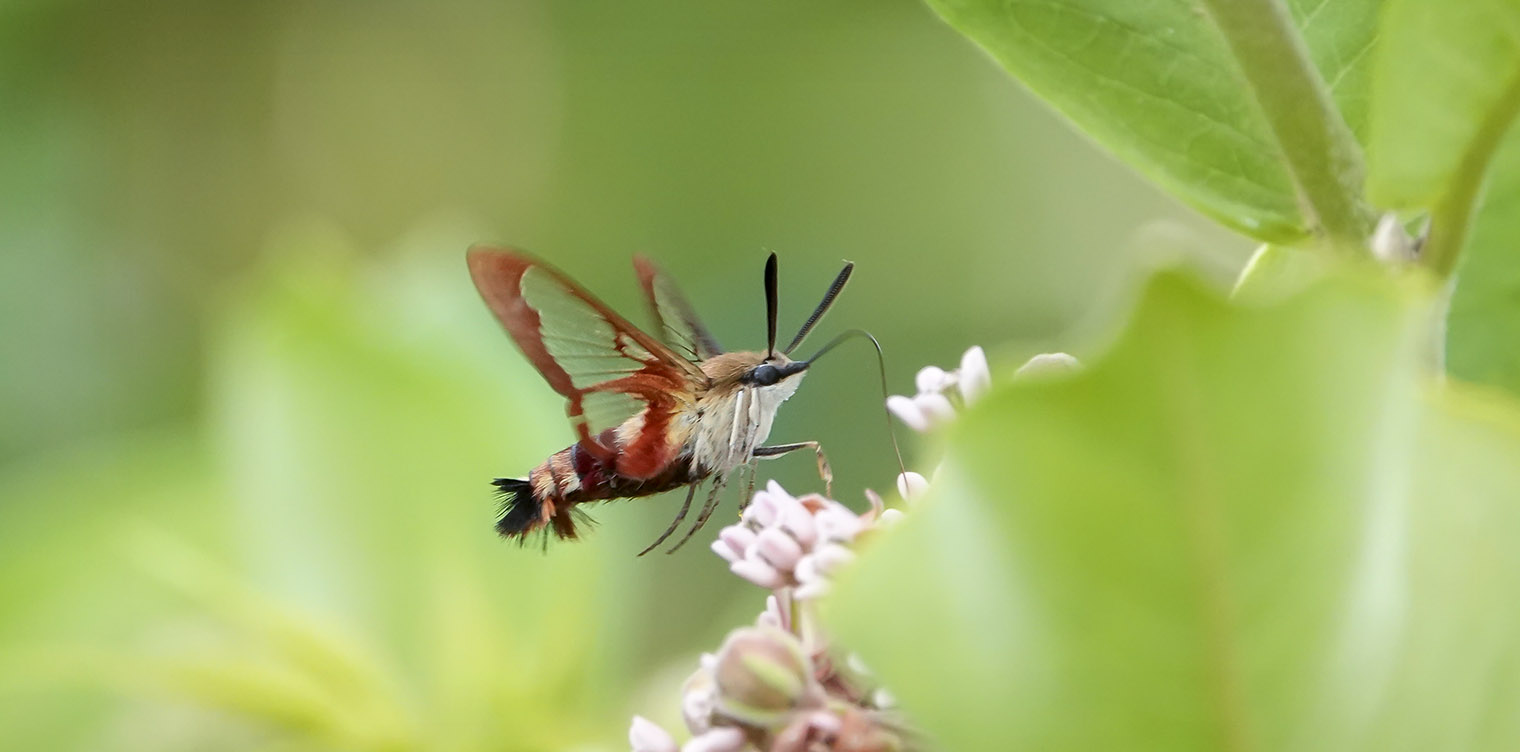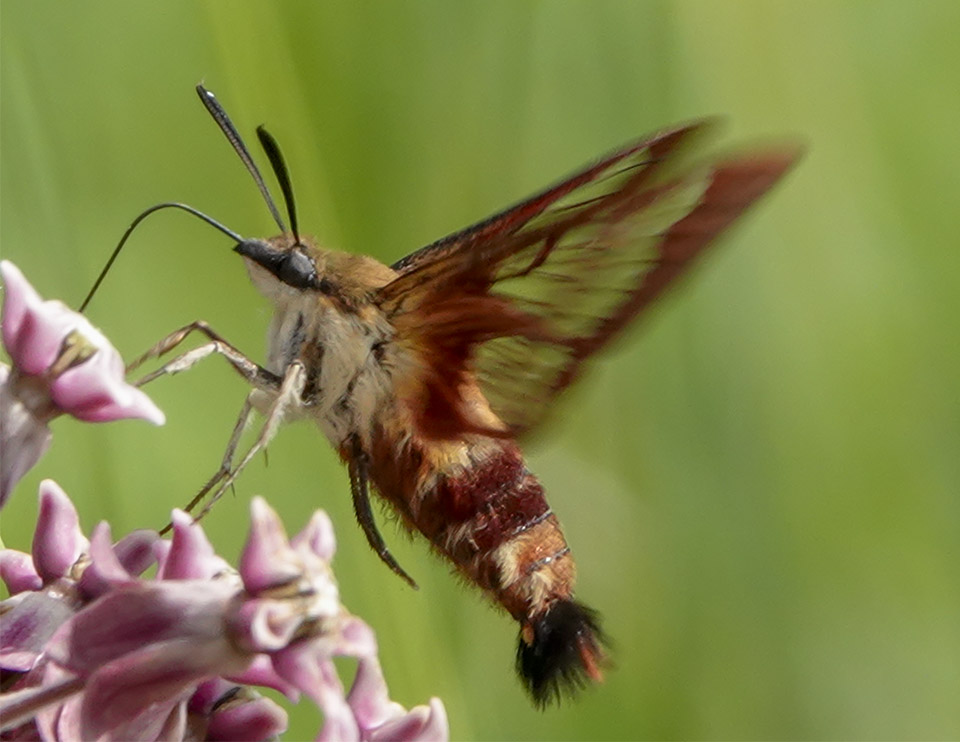Butterflies & Moths of the Adirondacks:
Hummingbird Clearwing (Hemaris thysbe)

The Hummingbird Clearwing (Hemaris thysbe) – also known as the Hummingbird Moth – is a small moth that may be seen in the Adirondack Mountains of upstate New York in summer. It is a member of the Sphingidae or Sphinx Moth family.
The nonscientific name reflects the fact that its movement mimics that of a hummingbird.
Hummingbird Clearwing: Identification
Adult Hummingbird Clearwings are dark burgundy and greenish-gold moths. The green body covering and burgundy wing scales suggest a small Ruby-throated Hummingbird. [1]
The Hummingbird Clearwing has wings which are mostly transparent with reddish brown terminal borders and dark scaling along the veins. Its legs are yellowish or pale. From above, the thorax is olive or golden olive. From below, the thorax is yellow. The abdomen is very dark burgundy from both above and below. [2] The wing span of the Hummingbird Clearwing is about 1½ to 2 inches.
Hummingbird Clearwing: Life History

Adult Hummingbird Clearwings, in contrast to many moths, are day fliers.[3] They fly during the daytime, hovering briefly at flowers to sip nectar. [4] [5] [6]
Caterpillar hosts include honeysuckle, snowberry, hawthorns, cherries, and plums. [7] [8] [9] Adults consume nectar from a wide variety of flowers including Japanese honeysuckle, lilac, snowberry, vetch, bee balm, red clover, monarda, Common Milkweed, Swamp Milkweed, Spreading Dogbane, hawkweeds, and phlox. [10] [11] [12] [13]
Hummingbird Clearwing: Habitat and Range
Hummingbird Clearwings reportedly are common in Canada and the eastern US, including New York State. [14] [15] Their habitat includes forests and woodlands, meadows and fields, as well as cities, suburbs, and towns. [16]
Hummingbird Clearwing: Flight
In the northern part of their range, adult Clearwings fly from April to August. In the Adirondacks, Hummingbird Clearwings appear to fly from late spring through August, depending on the weather.
- In 2012, they were present in the Paul Smiths VIC Native Species Butterfly House through much of the summer.[17] In 2014, this species was seen in the Butterfly House in late May, late June, and early July. [18] In 2018, Hummingbird Clearwings were reported in the Adirondacks in June and early August. [19] Hummingbird Clearwings were present in the Paul Smith's College VIC Butterfly House and nearby garden in early August 2018.[20]
- The pattern of Hummingbird Clearwing observations recorded on iNaturalist suggests a flight period from early June through late August. [21]
References
- Susan Grimm Hanley. Interpretive Naturalist, Paul Smith's College Native Species Butterfly House. Species Logbooks.
- Butterflies and Moths of North America. Species Profiles. Sighting records: 8/4/2012; 8/4/2012, 7/10/2013; 5/29/2014; 6/21/2014; 7/12/2014; 8/11/2018; 8/11/2018.
- Iowa State University. Department of Entomology. BugGuide. Hummingbird Clearwing. Hemaris thysbe. Retrieved 8 January 2020.
- Insect Images. Hummingbird Clearwing. Retrieved 8 January 2020.
- Sphingidae of the United States. Hemaris thysbe. Retrieved 8 January 2020.
- Charles V. Covell, Jr. A Field Guide to the Moths of Eastern North America (Houghton Mifflin Company, 1984), p. 40, Plate 6.
- David Carter. Butterflies and Moths (Dorling Kindersley, Inc., 1992), p. 242.
- David Beadle and Seabrooke Leckie. Peterson Field Guide to Moths of Northeastern North America (Houghton Mifflin Harcourt Publishing Company, 2012), pp. 264-265.
- Naturalist. Hummingbird Clearwing. Hemaris thysbe. Retrieved 29 June 2021.
- iNaturalist. Adirondack Park Sightings. Hummingbird Clearwing. Hemaris thysbe. Retrieved 29 June 2021.
- Naturalist. Adirondack Park Sightings 2016. Hummingbird Clearwing. Hemaris thysbe. Retrieved 29 June 2021.
- iNaturalist. Adirondack Park Sightings 2017. Hummingbird Clearwing. Hemaris thysbe. Retrieved 29 June 2021.
- iNaturalist. Adirondack Park Sightings 2018. Hummingbird Clearwing. Hemaris thysbe. Retrieved 29 June 2021.
- iNaturalist. Adirondack Park Sightings 2019. Hummingbird Clearwing. Hemaris thysbe. Retrieved 29 June 2021.
- iNaturalist. Adirondack Park Sightings 2020. Hummingbird Clearwing. Hemaris thysbe. Retrieved 29 June 2021.
- John Eastman. The Book of Swamp and Bog: Trees, Shrubs, and Wildflowers of Eastern Freshwater Wetlands (Stackpole Books, 1995), pp. 120-122.
- John Eastman. The Book of Forest and Thicket: Trees, Shrubs, and Wildflowers of Eastern North America (Stackpole Books, 1992), pp. 95-99, 108-110.
- John Eastman. The Book of Field and Roadside: Open-Country Weeds, Trees, and Wildflowers of Eastern North America (Stackpole Books, 2003), pp. 35-37, 160-162, 209-211, 260, 311.
